1. The point on the parabola \[2y=x^{2}\] , which
is nearest to the point (0, 3) is
a) \[\left(\pm 4, 8\right)\]
b) \[\left(\pm 1, \frac{1}{2}\right)\]
c) \[\left(\pm 2, 2\right)\]
d) \[\left(\pm 3, \frac{9}{2}\right)\]
Explanation: Let the point on the parabola 2y = x2 be

2. A dynamite blast blows a heavy rock
straight up with a launch velocity of 160 m/sec. It reaches a
height of \[s=160t-16t^{2}\] after t sec. The velocity of the rock
when it is 256 m above the ground on the way up is
a) 98 m/s
b) 96 m/s
c) 104 m/s
d) 48 m/s
Explanation:

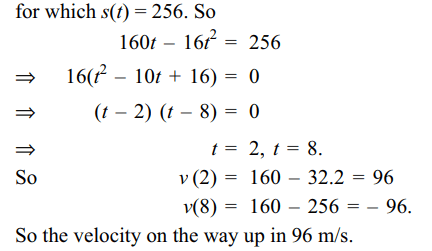
3. Let f be a twice differentiable function
such that \[f"\left(x\right)> 0,x\epsilon R\] . then the function defined by
\[h\left(x\right)=2f\left(\frac{x^{2}}{2}\right)+f\left(6-x^{2}\right) ,x\epsilon R\]
a) increases on\[\left(-2 ,\infty\right)\]
b) increases on \[\left(-\infty ,\infty\right)\]
c) increases on \[\left(0 ,\infty\right)\]
d) increases on\[\left(-2 ,\infty\right)\sim \left[0,2\right]\]
Explanation:

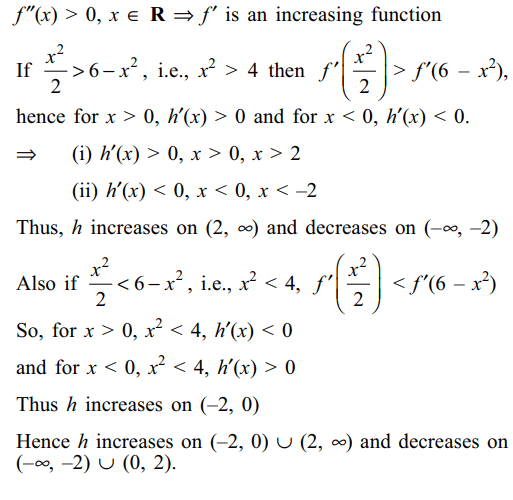
4. The coordinates of the point P(x, y) lying
in the first quardant on the ellipse \[x^{2}/8+y^{2}/18=1\] so that
the area of the triangle formed by the tangent at P and the
coordinate axes is the smallest, are given by
a) (2, 3)
b) \[\left(\sqrt{8},0\right)\]
c) \[\left(\sqrt{18},0\right)\]
d) none of these
Explanation: Any point on the ellipse is given by

5. The point(s) on the curve \[y^{3}+3x^{2}=12y\] where the tangent is vertical is/are
a) \[\left(\pm 4/\sqrt{3},-2\right)\]
b) \[\left(\pm \sqrt{11/3},1\right)\]
c) (0, 0)
d) \[\left(\pm 4/\sqrt{3},2\right)\]
Explanation: Differentiating the given curve w.r.t. x, we get

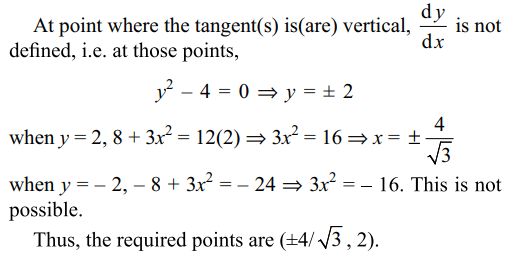
6. The equation of the common tangent to the curve \[y^{2}=8x\] and xy=-1 is
a) 3y = 9x + 2
b) y = 2x + 1
c) 2y = x + 8
d) y = x + 2
Explanation: A point on the curve xy = -1 is of the form

7. If a, b> 0 then minimum value of \[y=\frac{b^{2}}{a-x}+\frac{a^{2}}{x},0< x< a\]
is
a) \[\frac{a+b}{a}\]
b) \[\frac{ab}{a+b}\]
c) \[\frac{1}{a}+\frac{1}{b}\]
d) none of these
Explanation:


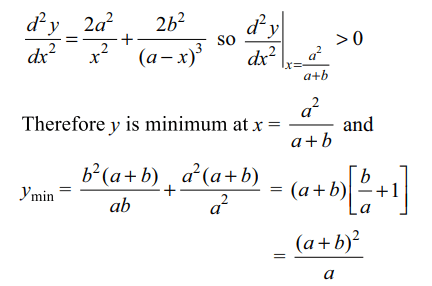
8. The curve \[y=ax^{3}+bx^{2}+cx+8\] touches
x-axis at P (-2 ,0) and cuts the y-axis at a point Q where its
gradient is 3 . The values of a, b, c are respectively
a) -1/2 ,-3/4,3
b) 3, -1/2 ,-4
c) -1/2 ,-7/4 ,2
d) -1/4 ,0, 3
Explanation:

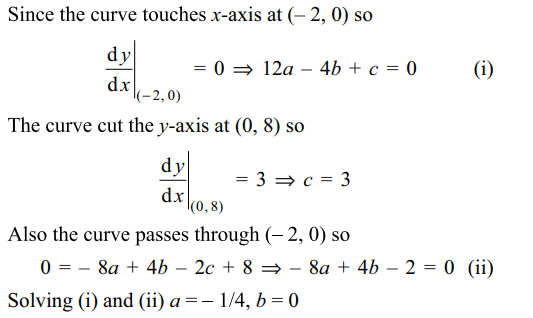
9. If the tangent at (1, 1) on \[y^{2}=x\left(2-x\right)^{2}\]
meets the curve again at P, then P is
a) (4, 4)
b) (–1, 2)
c) (9/4 ,3/8)
d) (3/4 ,3/8)
Explanation:

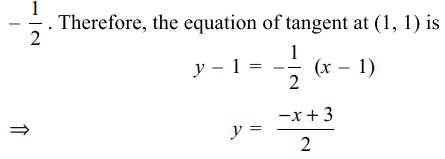

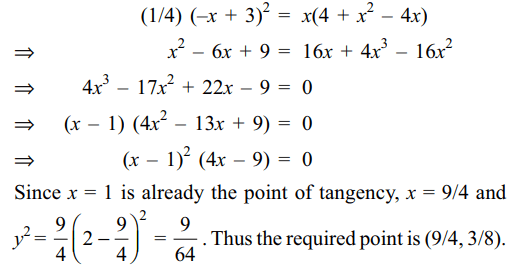
10. The tangent to the curve \[x=a\sqrt{\cos 2\theta}\cos\theta,y=a\sqrt{\cos 2\theta} \sin\theta\]
at the point corresponding to
\[\theta =\pi/6\] is
a) parallel to the x-axis
b) parallel to the y-axis
c) parallel to line y = x
d) parallel to the line y = –x
Explanation:

